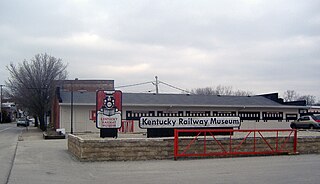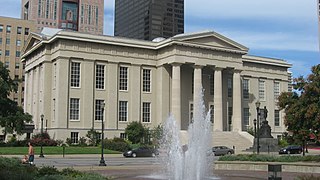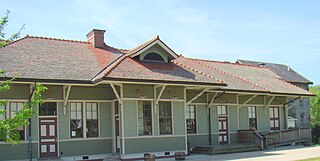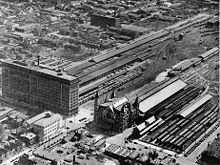
The Louisville and Nashville Railroad, commonly called the L&N, was a Class I railroad that operated freight and passenger services in the southeast United States.

The Union Station of Louisville, Kentucky is a historic railroad station that serves as offices for the Transit Authority of River City (TARC), as it has since mid-April 1980 after receiving a year-long restoration costing approximately $2 million. It was one of at least five union stations in Kentucky, amongst others located in Lexington, Covington, Paducah and Owensboro. It was one of three stations serving Louisville, the others being Central Station and Southern Railway Station. It superseded previous, smaller, railroad depots located in Louisville, most notably one located at Tenth and Maple in 1868–1869, and another L&N station built in 1858. The station was formally opened on September 7, 1891, by the Louisville and Nashville Railroad. There was a claim made at the time that it was the largest railroad station in the Southern United States, covering forty acres. The other major station in Louisville was Central Station, serving the Baltimore and Ohio, the Illinois Central and other railroads.

The Kentucky Railway Museum, now located in New Haven, Kentucky, United States, is a non-profit railroad museum dedicated to educating the public regarding the history and heritage of Kentucky's railroads and the people who built them. Originally created in 1954 in Louisville, Kentucky, the museum is at its third location, in extreme southern Nelson County. It is one of the oldest railroad stations in the United States.
The Memphis, Clarksville and Louisville Railroad (MC&L) was a railway in the southern United States. It was chartered in Tennessee in 1852, and opened in 1859. The MC&L entered receivership after the American Civil War, and financial troubles led to an 11-day strike in 1868 that ended when Louisville and Nashville Railroad (L&N) leased the line. L&N finally purchased the MC&L in 1871 and operated it as its Memphis Branch. L&N was merged into CSX, and CSX sold the former MC&L line to R.J. Corman Railroad Group in 1987, becoming that company's Memphis Line.

Crescent Hill is a neighborhood four miles (6 km) east of downtown Louisville, Kentucky USA. This area was originally called "Beargrass" because it sits on a ridge between two forks of Beargrass Creek. The boundaries of Crescent Hill are N Ewing Ave to the St. Matthews city limit by Brownsboro Road to Lexington Road. Frankfort Avenue generally bisects the neighborhood.
Highland Park was a city near and eventually neighborhood in Louisville, Kentucky, United States, that was razed as a part of the expansion of Louisville International Airport. Its boundaries were roughly the CSX railroad tracks to the west, and what would become the Kentucky State Fair & Exposition Center and the airport on all other sides.

The Louisville Metro Hall is the center of Louisville, Kentucky's government. It currently houses the Mayor's Office and the Jefferson County Clerk's Office for marriage licensing, delinquent tax filings, and the deeds room. The building was placed on the National Register of Historic Places in 1972. Construction began in 1836, and both the City of Louisville and Jefferson County governments starting using it in 1842.
The Louisville and Nashville Depot, or Louisville and Nashville Railroad Depot or Louisville and Nashville Passenger Station, Louisville and Nashville Railroad Passenger Depot or variations, may refer to the following former and active train stations previously used by the Louisville and Nashville Railroad. Some of these are listed on the National Register of Historic Places (NRHP).

The Historic Railpark and Train Museum, formerly the Louisville and Nashville Railroad Station in Bowling Green, Kentucky, is located in the historic railroad station. The building was placed on the National Register of Historic Places on December 18, 1979. Opened in 1925, the standing depot is the third Louisville & Nashville Railroad depot that served Bowling Green.

Stanford L&N Railroad Depot, also known as Baughman's Mill and Stanford Railroad Depot, is a historic train depot located in Stanford, Kentucky. It was built in 1911 and was used by the Louisville and Nashville Railroad.

The L & N Railroad Depot in the Hopkinsville Commercial Historic District of Hopkinsville, Kentucky is a historic railroad station on the National Register of Historic Places. It was built by the Louisville & Nashville Railroad in 1892.

The Nashville, Chattanooga, and St. Louis Railway Office and Freight House, simply known as the Paducah Freight House, is a historic railroad freight depot located in the southern portion of downtown Paducah, Kentucky.

The Union Station in Owensboro, Kentucky, is a historic railroad station, built in 1905. Built mostly for the Louisville and Nashville Railroad, the station is made of limestone and slate, and currently is home to several businesses.

The Bardstown station, also known as Old L & N Station, is a historic railroad station on the National Register of Historic Places in the northernmost section of the Bardstown Historic District of Bardstown, Kentucky. Long owned by the Louisville and Nashville Railroad (L&N), it is currently used as the station for the My Old Kentucky Dinner Train, owned by the R.J. Corman Railroad Group.

Louisville & Nashville 152 is a preserved K-2a class 4-6-2 "Pacific" type steam locomotive listed on the National Register of Historic Places, currently homed at the Kentucky Railway Museum at New Haven, Kentucky in southernmost Nelson County, Kentucky. It is the oldest known remaining 4-6-2 "Pacific" type locomotive to exist. It is also the "Official State Locomotive of Kentucky", designated as such on March 6, 2000. The locomotive is currently owned and being restored back to operating condition by the Kentucky Railway Museum.

The Louisville and Nashville Depot, located at 101 East Railroad Street in Nashville, Illinois, is the city's former Louisville and Nashville Railroad station. The station was built in 1885 as part of the L&N's expansion through Southern Illinois in the 1880s. The building has a simple vernacular design common to L&N depots in small towns, which were intended to be functional rather than elaborate. The railroad exported the products of Washington County's industries, which included coal, dairy products, grain, and lumber, through the station; it also imported goods such as automobiles, fertilizer, and commercial products. In addition, the railroad provided passenger service to Nashville; at the peak of service, seven daily passenger trains stopped at the depot, and students in other parts of the county used the trains to attend Nashville's high school. The depot also served as an information center for Nashville; the city's telegraph station was located at the depot, and St. Louis daily newspapers arrived by train. The depot remained in service as late as the 1950s but closed sometime prior to 1984.

The Greenback Depot is a former railroad station located in Greenback, Tennessee, United States. Built in 1914 by the Louisville and Nashville Railroad (L&N), the depot served rail freight and passengers traveling in and out of the Greenback area until 1954. Restored for use as a community events center by Ronald Edmondson in the early 2010s, the depot was listed on the National Register of Historic Places in 2013 in recognition of its role in the area's transportation history.

The Louisville and Nashville Railroad Depot is a historic train station in Cullman, Alabama. The depot was built in 1913 as a replacement for Cullman's original station. Cullman's founder, John G. Cullmann, gave money to the city upon his death in 1895 to lower the Louisville and Nashville Railroad tracks through town, in order to reduce noise and pollution. The plan was not enacted until 1911, when the L&N laid double tracks through the town, necessitating the construction of a new depot. The depot served passengers until 1968, and was used for maintenance storage by new owners CSX until it was sold to the city in 1990. It was restored and now houses offices for the local United Way chapter.

The Northern Pacific Office Building is a three-story historic office building in Tacoma, Washington that served as the headquarters of the Northern Pacific Railway's Tacoma division. Built in 1888, the brick, stucco, stone and cast iron structure stands on a high bluff overlooking the Commencement Bay harbor and extensive railroad switching yards that fan out across the tide flats below at the mouth of the Puyallup River where it flows into Puget Sound. The flats are densely developed with heavy industry that has grown up around the railroad facilities and the Port of Tacoma. The site was originally a choice location across from the Tacoma City Hall and at the north end of Pacific Avenue, the main street through the city's central business district.

Louisville and Nashville Railroad Station, also known as L & N Station, was a historic train station located in downtown Evansville, Indiana. It was built in 1902 for the Louisville and Nashville Railroad, and was a Richardsonian Romanesque style rock-faced limestone building. It consisted of a three-story central block with two-story flanking wings, and a one-story baggage wing. It had projecting gabled pavilions and a slate hipped roof.




















